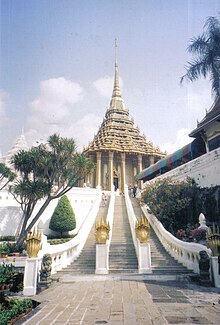Wat Phra Phutthabat
The Wat Phra Phutthabat ( Thai : วัด พระพุทธบาท , full name: Wat Phra Phutthabat Ratchaworamahaviharn - วัด พระพุทธบาท ราชวรมหาวิหาร , Great Royal Temple with the footprint of the Buddha ) is a Buddhist temple complex ( Wat ) in the province ( Changwat ) Saraburi , central Thailand . Wat Phra Phutthabat is a " First Class Royal Temple ".
location
Wat Phra Phutthabat is located 28 kilometers north of the city of Saraburi in the district ( Amphoe ) Phra Phutthabat ( Tambon Khun Khlon ). Highway 1 passes directly in front of the temple.
history
The greatest attraction and at the same time namesake of the entire complex is the Buddha's footprint discovered by a hunter named Bun on the hill Satchaphanthakhiri during the reign of King Songtham (r. 1610 / 1620–1628) .
At the beginning of his reign, King Songtham sent a group of monks to Ceylon to pay homage to one of the Buddha's footprints there. They are considered to be symbols of the various abodes of the Gautama Buddha . The monks were surprised to hear that there should also be such a footprint in Thailand . The king had a search for this imprint and the said hunter actually found one: on closer inspection, however, it was more of a small basin filled with water. After drinking from it, he was cured of a protracted skin condition.
Thereupon the king ordered the building of a temple at this place. A mondop was erected over the footprint in 1765 and richly decorated. The complex was badly destroyed and plundered by the Burmese after the conquest of Ayutthaya in 1767.
The Mondop that surrounds the footprint today dates from the late 18th century. The ubosot and viharn are built in the style of the late Ayutthaya architecture and the Rattanakosin period.
Attractions
In addition to the footprint, the stairs leading up to the Mondop on the small hill are interesting. It is modeled on the ladder to heaven that Buddha used on his return from Buddhist paradise, a three-flight staircase made of gold, silver and crystal. Each handrail begins at the bottom with a five-headed bronze Naga snake, the body of which snakes up to the top.
The Mondop itself has a square floor plan and merges into a seven-story roof made of green ceramic tiles. Each floor is decorated with small niches. The roof is supported by rectangular pillars with recessed corners. They are gilded and decorated with heavenly beings and lotus buds made of crystalline material. The doors are inlaid with mother-of-pearl and were created by craftsmen under King Boromakot . The central footprint on the inside is about 52 cm wide, 180 cm long and 27 cm deep.
Numerous bells are arranged around the building.
Located on the site of a museum , the porcelain , pottery from Sawankhalok , clothing from the 17th century and ancient bronze ware issues. You can also see old weapons and the old roof structure that was on the Mondop.
literature
- Clarence Aasen: Architecture of Siam: A Cultural History and Interpretation. Oxford University Press, Oxford 1998, ISBN 983-56-0027-9 .
- Theodorus Jacobus van den Heuvel (Remco Raben, Dhiravat na Pombejra, ed.): In the King's Trail. An 18th Century Dutch Journey to the Buddha's Footprint ( Theodorus Jacobus van den Heuvel's account of his voyage to Phra Phutthabat in 1737 ). The Royal Nederlands Embassy, Bangkok 1997, ISBN 974-89926-5-9 .
- The Phrabat, or Holy Footprint. In: Henry Alabaster: The Wheel of the Law . Trübner & Co., London 1871. (Reprint: Kessinger Publishing, Kila 1998, ISBN 0-7661-0426-5 )
- Klaus Rosenberg: The Bunnōwāt kham dian of the monk Nāk. In: Oriens Extremus. Volume 17, No. 1/2, Harrassowitz Verlag, 1970, pp. 179-217, 219.
Web links
- Wat Phra Phuttabat: Saraburi. wat-thai-temple.blogspot.com
- Traveling in Thailand: Phra Phutthabat 2003. Pilgrimage to Buddha's footsteps. hdamm.de
Coordinates: 14 ° 43 ′ 6 ″ N , 100 ° 47 ′ 19 ″ E

